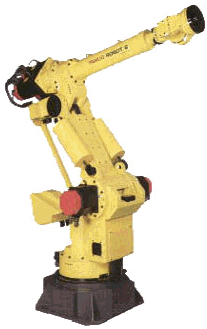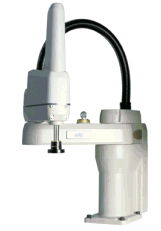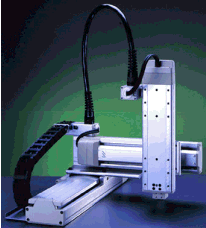|
|
Industrial Robots
|
Modern industrial robots are true marvels
of engineering. A robot the size of a person can easily carry
a load over one hundred pounds and move it very quickly with a
repeatability of +/-0.006 inches. Furthermore these robots can
do that 24 hours a day for years on end with no failures
whatsoever. Though they are reprogrammable, in many
applications (particularly those in the auto industry) they
are programmed once and then repeat that exact same task for
years. A six-axis robot like the yellow one
below costs about $60,000. What I find interesting is that
deploying the robot costs another $200,000. Thus, the cost of
the robot itself is just a fraction of the cost of the total
system. The tools the robot uses combined with the cost of
programming the robot form the major percentage of the cost.
That's why robots in the auto industry are rarely
reprogrammed. If they are going to go to the expense of
deploying a robot for another task, then they may as well use
a new robot. |
|
|
 |
This is pretty much the typical machine
people think of when they think of industrial robots. Fanuc
makes this particular robot. Fanuc is the largest maker of
these type of robots in the world and they are almost always
yellow. This robot has six independent joints, also called six
degrees of freedom. The reason for this is that arbitrarily
placing a solid body in space requires six parameters; three
to specify the location (x, y, z for example) and three to
specify the orientation (roll, yaw, pitch for example).
If you look closely you will see two cylindrical pistons on
the side of the robot. These cylinders contain
"anti-gravity" springs that are a big part of the
reason robots like these can carry such heavy loads. These
springs counter-balance against gravity similar to the way the
springs on the garage door make it much easier for a person to
lift.
You will see robots like these welding, painting and
handling materials. |
|
|
|
The robot shown at right is
made by an American company, Adept Technology. Adept is
America's largest robot company and the world's leading
producer of SCARA robots. This is actually the most common
industrial robot. SCARA stands for Selective Compliance
Articulated (though some folks use Assembly here) Robot
Arm. The robot has three joints in the horizontal plane
that give it x-y positioning and orientation parallel
to the plane. There is one linear joint that
supplies the z positioning. This is the typical
"pick and place" robot. When combined with a
vision system it can move product from conveyor belt to
package at a very high rate of speed (think "Lucy
and the candies" but way faster).
The robot's joint structure
allows it to be compliant (or soft) to forces in the
horizontal plane. This is important for "peg in
hole" type applications where the robot will
actually flex to make up for inaccuracies and allow very
tight part fits.
|

|
|
|
|
|

|
The machine at left can be called a
Cartesian robot, though calling this machine a robot is really
stretching the definition of a robot. It is Cartesian because it allows x-y-z positioning. Three
linear joints provide the three axes of motion and define the
x, y and z planes. This robot is
suited for pick and place applications where either there are
no orientation requirements or the parts can be pre-oriented
before the robot picks them up (such as surface mounted
circuit board assembly).. |
|
|
|
|